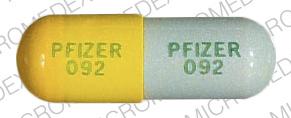Urobiotic-250 and Alcohol/Food Interactions
There are 2 alcohol/food/lifestyle interactions with Urobiotic-250 (oxytetracycline / phenazopyridine / sulfamethizole).
Oxytetracycline Multivitamins With Minerals
Moderate Drug Interaction
Consumer information for this interaction is not currently available.
GENERALLY AVOID: The oral bioavailability of quinolone and tetracycline antibiotics may be reduced by concurrent administration of preparations containing polyvalent cations such as aluminum, calcium, iron, magnesium, and zinc. Therapeutic failure may result. The proposed mechanism is chelation of quinolone and tetracycline antibiotics by di- and trivalent cations, forming an insoluble complex that is poorly absorbed from the gastrointestinal tract. Reduced gastrointestinal absorption of the cations should also be considered.
MANAGEMENT: Concomitant administration of oral quinolone and tetracycline antibiotics with preparations containing aluminum, calcium, iron, magnesium, and/or zinc salts should generally be avoided. Otherwise, the times of administration should be staggered by as much as possible to minimize the potential for interaction. Quinolones should typically be dosed either 2 to 4 hours before or 4 to 6 hours after polyvalent cation preparations, depending on the quinolone and formulation. Likewise, tetracyclines and polyvalent cation preparations should typically be administered 2 to 4 hours apart. The prescribing information for the antibiotic should be consulted for more specific dosing recommendations.
Oxytetracycline Food/Lifestyle
Moderate Food Interaction
Consumer information for this interaction is not currently available.
ADJUST DOSING INTERVAL: Administration with food, particularly dairy products, significantly reduces tetracycline absorption. The calcium content in some foods can form nonabsorbable chelates with tetracycline.
MANAGEMENT: Tetracycline should be administered one hour before or two hours after meals. Because oral tetracycline has caused rare cases of esophagitis and esophageal ulceration, patients should be advised to take tetracycline with a large glass of water while standing or sitting upright and to avoid laying down immediately afterwards.
Switch to professional interaction data
Urobiotic-250 drug interactions
There are 293 drug interactions with Urobiotic-250 (oxytetracycline / phenazopyridine / sulfamethizole).
Urobiotic-250 disease interactions
There are 9 disease interactions with Urobiotic-250 (oxytetracycline / phenazopyridine / sulfamethizole) which include:
- colitis
- G-6-PD deficiency
- hepatitis
- renal dysfunction
- hematologic toxicity
- hemodialysis
- hepatotoxicity
- renal dysfunction
- esophageal irritation
Drug Interaction Classification
| Highly clinically significant. Avoid combinations; the risk of the interaction outweighs the benefit. | |
| Moderately clinically significant. Usually avoid combinations; use it only under special circumstances. | |
| Minimally clinically significant. Minimize risk; assess risk and consider an alternative drug, take steps to circumvent the interaction risk and/or institute a monitoring plan. | |
| No interaction information available. |
See also:
Augmentin
Augmentin is a prescription antibiotic combining amoxicillin and clavulanate to treat bacterial ...
Bactrim
Bactrim (sulfamethoxazole and trimethoprim) is an antibiotic used to treat ear infections, urinary ...
Botox
Botox is used cosmetically to reduce facial lines and wrinkles and for medical purposes for ...
Macrobid
Macrobid (nitrofurantoin) is an antibiotic used to treat urinary tract infections. Includes side ...
Sulfamethoxazole/trimethoprim
Sulfamethoxazole/trimethoprim is used for acne, bacterial infection, bacterial skin infection ...
Amoxicillin/clavulanate
Amoxicillin and clavulanate potassium is a combination antibiotic used to treat bacterial ...
Nitrofurantoin
Nitrofurantoin is an antibiotic used to treat urinary tract infections. Learn about side effects ...
Levofloxacin
Levofloxacin is a fluoroquinolone antibiotic used to treat serious bacterial infections and prevent ...
Ceftriaxone
Ceftriaxone is used for bacteremia, bacterial endocarditis prevention, bacterial infection, bone ...
Ciprofloxacin
Ciprofloxacin is an antibiotic belong to a group of drugs called fluoroquinolones. Learn about side ...
Further information
Always consult your healthcare provider to ensure the information displayed on this page applies to your personal circumstances.


